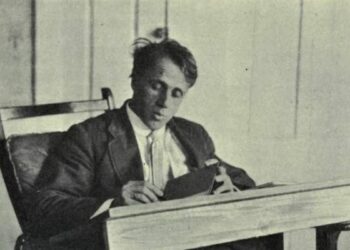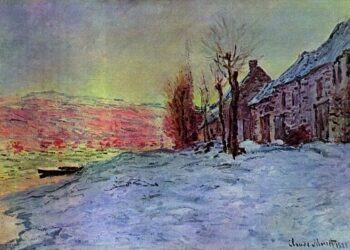“The Lake Isle of Innisfree” by W.B. Yeats Poem Summary
The well-known poem “The Lake Isle of Innisfree” was written by Irish poet and Nobel winner William Butler Yeats. The poem, written by Yeats and published in 1890, expresses his desire for a tranquil life in the countryside, free from the commotion and clamour of the city. It has grown to be one of his most cherished creations and a symbol of his ties to his Irish ancestry.
The Lake Isle of Innisfree by W.B. Yeats Summary-The speaker of the poem begins by expressing his desire to flee to the quiet island of Innisfree in Lough Gill in County Sligo, Ireland. The speaker draws attention to the attractiveness of this exquisite setting, where he can find comfort and peace.
The bustling city, from which the speaker seeks escape, serves as the backdrop for this yearning for a different way of living.
Also Read-
- “The Chimney Sweeper” by William Blake Poem Summary
- “Elegy Written in a Country Churchyard” by Thomas Gray Poem Summary
- “She Walks in Beauty” by Lord Byron Poem Summary
- “The Ballad of Reading Gaol” by Oscar Wilde Poem Summary
The Lake Isle of Innisfree by W.B. Yeats Summary-Yeats paints a richly detailed picture of the landscape as he eloquently captures the grandeur of Innisfree. He mentions the existence of a cabin that he plans to construct using island-found natural resources.
The Lake Isle of Innisfree by W.B. Yeats Summary-There will be a tiny garden there that the speaker intends to tend, with beans and honeybees. With this motif, a sense of independence and a return to a more simple, natural way of life are suggested.
The Lake Isle of Innisfree by W.B. Yeats Summary-The speaker’s intense longing for the simplicity and tranquilly that Innisfree offers is the poem’s main theme. The poem’s repeated use of the line “I will arise and go now” serves to emphasise the speaker’s resolve to flee the city and find solace in nature. The speaker’s ideal getaway is Innisfree, where he or she may get back in touch with nature and live a more sincere life.
The Lake Isle of Innisfree by W.B. Yeats Summary-The speaker emphasises the sensory impressions he anticipates as the poem goes on to further depict the appeal of Innisfree. He longs to hear the sounds of crickets chirping, bees buzzing, and lake water lapping. The tranquilly and peace that these natural sounds offer serve as a dramatic contrast to the clamour and commotion of city life.
Yeats takes the reader to Innisfree by using vivid visual imagery. In his description of the lake’s surface, he used phrases like “purple glimmering” and “midnight’s all a glimmer.” The speaker’s desire for a beautiful and magical location is conveyed through these descriptions, which arouse a feeling of enchantment in the reader.
The Lake Isle of Innisfree by W.B. Yeats Summary-The final part of the poem interrupts the lovely flight to Innisfree by returning the reader to the realities of the urban setting. The speaker admits that despite his longing for the tranquil haven of the island, he must remain in the metropolis. He is aware of the importance of his visions of Innisfree for his well-being, yet he still has to deal with the challenges of city living.
The Lake Isle of Innisfree by W.B. Yeats Summary-The poem “The Lake Isle of Innisfree” covers themes of escape, a yearning for simplicity, and the need for a human connection to nature. Yeats expresses his desire for a serene setting in the midst of the upheaval of modern life with vivid imagery and expressive words. The poem strikes a chord with readers, prompting them to consider their own yearnings for a more straightforward and fulfilling life.
The Lake Isle of Innisfree Poem
I will arise and go now, and go to Innisfree,
And a small cabin build there, of clay and wattles made:
Nine bean-rows will I have there, a hive for the honey-bee;
And live alone in the bee-loud glade.
And I shall have some peace there, for peace comes dropping slow,
Dropping from the veils of the morning to where the cricket sings;
There midnight’s all a glimmer, and noon a purple glow,
And evening full of the linnet’s wings.
I will arise and go now, for always night and day
I hear lake water lapping with low sounds by the shore;
While I stand on the roadway, or on the pavements grey,
I hear it in the deep heart’s core.
Conclusion
“The Lake Isle of Innisfree” by William Butler Yeats is a timeless poem that captures the universal longing for a peaceful and idyllic existence in nature.
The Lake Isle of Innisfree by W.B. Yeats Summary-Through vivid imagery and evocative language, Yeats transports the reader to the serene island of Innisfree, where the speaker seeks solace from the noise and chaos of urban life.
The Lake Isle of Innisfree by W.B. Yeats Summary-The poem expresses a deep yearning for simplicity and a return to a more natural way of living. It emphasizes the importance of finding balance in a world dominated by modernity and urbanization. Innisfree represents a sanctuary, a place where one can reconnect with nature and find a sense of inner peace.
The Lake Isle of Innisfree by W.B. Yeats Summary-Yeats’ use of sensory details, such as the sights, sounds, and sensations of Innisfree, allows the reader to fully immerse themselves in the speaker’s longing. The poem’s repetition of the phrase “I will arise and go now” emphasizes the speaker’s determination to pursue this escape and highlights the power of the natural world to rejuvenate and restore the human spirit.
Despite the speaker’s yearning for Innisfree, the final stanza acknowledges the reality of the urban environment and the need to confront its complexities.
This recognition adds a layer of complexity to the poem, suggesting that while the desire for simplicity and connection with nature is profound, it is not always attainable or sustainable in its purest form.
The Lake Isle of Innisfree by W.B. Yeats Summary-“The Lake Isle of Innisfree” continues to resonate with readers across generations, as it taps into a fundamental human longing for a simpler and more meaningful existence.
The Lake Isle of Innisfree by W.B. Yeats Summary-It serves as a reminder of the importance of finding moments of peace and solace amidst the demands of modern life and encourages us to seek out our own personal “isle of Innisfree” where we can reconnect with nature and find inner harmony.
FAQ.
Q: Who wrote “The Lake Isle of Innisfree”?
A: “The Lake Isle of Innisfree” was written by William Butler Yeats, an Irish poet and Nobel laureate.
Q: When was “The Lake Isle of Innisfree” published?
A: The poem was published in 1890.
Q: What is the theme of “The Lake Isle of Innisfree”?
A: The main themes of the poem include escapism, the longing for simplicity, and the desire for a connection with nature.
Q: Where is Innisfree located?
A: Innisfree is an island in Lough Gill, County Sligo, Ireland.




